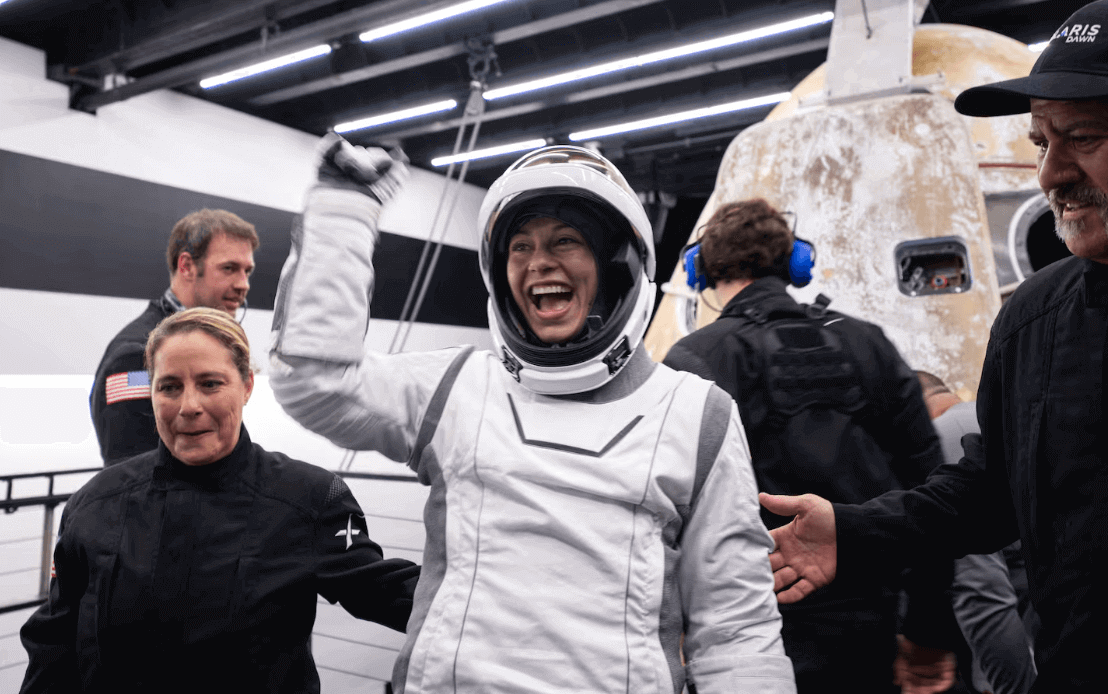北极星黎明号宇航员在首次私人太空行走后返回地球

【中美创新时报2024 年 9 月 16 日编译讯】(记者温友平编译)在进行了有史以来第一次商业太空行走并比半个多世纪以来任何人都离地球更远之后,北极星黎明号任务的宇航员于周日早些时候安全返回地球。《纽约时报》记者Yan Zhuang对此作了下述报道。
据 SpaceX 直播显示,SpaceX 载人龙飞船太空舱于凌晨 3:30 后不久在佛罗里达州干龟岛海岸附近的墨西哥湾溅落,载有亿万富翁企业家贾里德·艾萨克曼和他的三名私人宇航员。
“我们的任务完成了,”艾萨克曼通过无线电报告说,此时太空舱在水中漂浮,等待着救援队。不到一小时,四人便走出飞船,高兴地挥舞着拳头,登上了甲板。
这是 SpaceX 首次在干龟群岛附近着陆,干龟群岛位于基韦斯特以西 70 英里处。为了庆祝新地点,SpaceX 员工将一个巨大的绿色海龟气球带到了位于加利福尼亚州霍桑的公司总部任务控制中心。该公司通常将目标定在靠近佛罗里达海岸的地方,但两周的恶劣天气预报促使 SpaceX 另寻他处。
这项雄心勃勃的太空任务是艾萨克曼和埃隆·马斯克的 SpaceX 合作完成的,在轨道上停留了五天,实现了私人太空飞行的几个里程碑,并进一步证明太空旅行和太空行走不再是 NASA 等政府机构专业宇航员的专属领域。
周二,载人龙飞船发射,此前因氦气泄漏和恶劣天气而推迟发射。飞船上有任务指挥官兼支付服务公司 Shift4 创始人艾萨克曼、SpaceX 员工莎拉·吉利斯和安娜·梅农,以及美国空军退役中校斯科特·波蒂特。
周二晚些时候,飞船轨道到达距地球表面约 870 英里的高点。这打破了 1966 年双子座 XI 任务创下的 853 英里高空的非月球任务宇航员飞行距离纪录,吉利斯和梅农也成为有史以来第一位飞离地球如此远的女性。
周四,艾萨克曼和吉利斯成为首批成功完成太空行走的私人宇航员。由于飞船没有气闸,因此宇航员在太空行走过程中将飞船内的所有空气放出,而其他两名宇航员则在真空舱内穿着宇航服。艾萨克曼走到舱外,对宇航服进行了几分钟的机动性测试,然后重新进入舱内。吉利斯随后走到舱外,进行了同样的测试。
这是三次北极星任务中的第一次,旨在加速实现马斯克有朝一日将人类送上火星的梦想所需的技术进步。该任务的一个关键目标是进一步开发更先进的宇航服,SpaceX 需要这些宇航服来尝试未来的任何外星殖民。
在发射前的新闻发布会上,艾萨克曼沉思道,有一天,有人可能会穿着 SpaceX 为这次飞行开发的宇航服踏上火星。离地球更近的商业太空行走也提供了其他可能性,比如技术人员在轨道上修理私人卫星。
在太空飞行期间,四名宇航员进行了大约 40 次实验,主要是关于失重和辐射如何影响人体。他们还测试了 Crew Dragon 与 SpaceX 的 Starlink 互联网卫星群之间的激光通信。
本报告使用了美联社的材料。
本文最初发表于《纽约时报》。
题图:周日,任务专家莎拉·吉利斯 (Sarah Gillis) 走出载人北极星黎明号任务的“龙”舱,该舱在佛罗里达州干龟岛海岸附近溅落,此前,北极星计划的非政府宇航员首次完成了载人航天任务。-/Polaris Program/AFP via Getty Images
附原英文报道:
Polaris Dawn astronauts return to Earth after first private spacewalk
By Yan Zhuang New York Times,Updated September 15, 2024
On Sunday, Sarah Gillis, mission specialist, stepped out of the manned Polaris Dawn mission’s “Dragon” capsule after it splashed down off the coast of Dry Tortugas, Fla., after completing the first human spaceflight mission by nongovernment astronauts of the Polaris Program.-/Polaris Program/AFP via Getty Images
After conducting the first-ever commercial spacewalk and traveling farther from Earth than anyone in more than half a century, the astronauts of the Polaris Dawn mission returned to Earth safely early Sunday.
The SpaceX Crew Dragon capsule splashed down in the Gulf of Mexico, off the coast of Dry Tortugas, Fla., shortly after 3:30 a.m., carrying Jared Isaacman, a billionaire entrepreneur, and his crew of three private astronauts, according to a SpaceX livestream.
“We are mission complete,” Isaacman radioed as the capsule bobbed in the water, awaiting the recovery team. Within an hour, all four were out of their spacecraft, pumping their fists with joy as they emerged onto the ship’s deck.
It was the first time SpaceX aimed for a splashdown near the Dry Tortugas, a cluster of islands 70 miles west of Key West. To celebrate the new location, SpaceX employees brought a big, green turtle balloon to Mission Control at company headquarters in Hawthorne, Calif. The company usually targets closer to the Florida coast, but two weeks of poor weather forecasts prompted SpaceX to look elsewhere.
The ambitious space mission, a collaboration between Isaacman and Elon Musk’s SpaceX, spent five days in orbit, achieved several milestones in private spaceflight, and was further evidence that space travel and spacewalks are no longer the exclusive domain of professional astronauts working at government agencies such as NASA.
The Crew Dragon capsule launched Tuesday, after delays because of a helium leak and bad weather. On board were Isaacman, the mission commander and the founder of the payment services company Shift4; Sarah Gillis and Anna Menon, SpaceX employees; and Scott Poteet, a retired US Air Force lieutenant colonel.
Late on Tuesday, its orbit reached a high point of about 870 miles above the Earth’s surface. That beat the record distance for astronauts on a mission not headed to the moon, which the Gemini XI mission set in 1966 at 853 miles high, and made Gillis and Menon the first women ever to fly so far from Earth.
Thursday, Isaacman and Gillis became the first private astronauts to successfully complete a spacewalk. The operation involved the crew letting all the air out of the spacecraft, because it had no airlock, while the other two crew members wore spacesuits inside the airless capsule. Isaacman moved outside and conducted mobility tests of his spacesuit for a few minutes before reentering the capsule. Gillis then moved outside and performed the same tests.
This was the first of three Polaris missions aimed at accelerating technological advances needed to fulfill Musk’s dream of sending people to Mars someday. A key goal of the mission was to further the development of more advanced spacesuits that would be needed for SpaceX to try any future off-world colonization.
During a news conference before the launch, Isaacman mused that one day, someone might step onto Mars wearing a version of the spacesuit that SpaceX had developed for this flight. Closer to Earth, commercial spacewalks also present other possibilities, like technicians repairing private satellites in orbit.
During the spaceflight, the four astronauts conducted about 40 experiments, mostly about how weightlessness and radiation affect the human body. They also tested laser communications between Crew Dragon and SpaceX’s constellation of Starlink internet satellites.
Material from the Associated Press was used in this report.
This article originally appeared in The New York Times.

